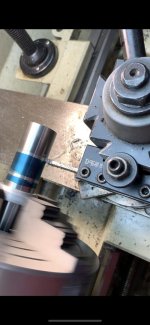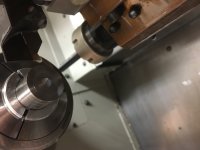You are using an out of date browser. It may not display this or other websites correctly.
You should upgrade or use an alternative browser.
You should upgrade or use an alternative browser.
Parting words
- Thread starter Bnhpr
- Start date
Ben,
This has come up on the forum before.
IIRC, in one of Bill Calfee's articles for Precision Shooting, he advised against using a parting tool when cutting a barrel as, in his opinion, this caused the barrel to become dimensionally larger due to the heat generated in the parting process. I think a lot of folks read that and stay away from their barrels with parting tools.
And IIRC, Jackie thinks that is complete rubbish, and uses a parting tool on barrels.
Justin
This has come up on the forum before.
IIRC, in one of Bill Calfee's articles for Precision Shooting, he advised against using a parting tool when cutting a barrel as, in his opinion, this caused the barrel to become dimensionally larger due to the heat generated in the parting process. I think a lot of folks read that and stay away from their barrels with parting tools.
And IIRC, Jackie thinks that is complete rubbish, and uses a parting tool on barrels.
Justin
Why not use a parting tool to cut barrels,
? Am I the only one doing this?
I'm all about "mechanisms"...... as in "what is the MECHANISM for the supposed good or bad thing" and why is the thing "good" or "bad?"
As in, "my bullets go to sleep and group tighter with distance" so I say "what is the MECHANISM, what is the force that turns them toward center??" AND.... show me proof, show empirical data, targets!
As in when someone says "weighing primers" or "culling brass" or "reaming flashholes" is imperative I ask "WHY?" and where's the measurable result??? Most often "the result" is touted as lower ES. So I have to ask, "but if I'm right now GETTING ES under 10fps without doing these things, "WHERE'S THE CONNECTION?"
When Jim Borden says "I won't letter/number-stamp barrels because it deforms the steel clear through to the inside" and furthermore explains the mechanism and states that "it can be detected empirically"
I lissen
When I hear "PUSHES/DEFORMS" with no explanation of WHAT is being "PUSHED/DEFORMED".... I go "huhh??" In my use of the cutter pictured it sometimes pulls the workpiece towards me....and facing/crowning ALSO can be said to "push/deform".... can't it?
Calfee sez "you turn a muzzle too small when threading for a muzzle device and it swells up, bells the bore".......OK...... so we can presume this is 'bad', and furthermore show it on targets. And FURTHER-furthermore..... we can find the belling using fitted plugs.... so I agree with him. And understand the mechanism...
Calfee sez "stopping the muzzle" and I go "huhh??" (He never went so far as to call me "funny people" but we argued this idea some!! LOL)
Calfee sez "dimensionally larger due to heat" I say "huhh??" So what's the mechanism??? Does the barrel swell up under cutting, work-harden on the cut face and STAY larger??? Or What?
I'm not buying in until someone can explain why it's bad, me.....
Dave Tooley
Active member
I've chambered thousand of barrels that have a tread relief groove at the shoulder. On my Haas I turn the tenon about .020" short and plunge in with a grooving tool to length. Every one has a visible ring where the turning tool made it's last pass. I've faced off another .020" one time just to see if it went away. It didn't. There is a definite change in grain structure where the tool makes the last pass up against the shoulder prior to facing it off.
Thanks and good points.
1. I have no issues grinding parting tools, feed rates and cutting speeds for 416
2. I always leave green when parting and face back to get dimensions right.
3. I’m not seeing heat issues, use coolant etc.
I just want to see if there is something i'm missing. Seems another gunsmithing wives tail.
1. I have no issues grinding parting tools, feed rates and cutting speeds for 416
2. I always leave green when parting and face back to get dimensions right.
3. I’m not seeing heat issues, use coolant etc.
I just want to see if there is something i'm missing. Seems another gunsmithing wives tail.
jackie schmidt
New member
I part barrels, leaving about 1/8 inch to face and crown.
I've chambered thousand of barrels that have a tread relief groove at the shoulder. On my Haas I turn the tenon about .020" short and plunge in with a grooving tool to length. Every one has a visible ring where the turning tool made it's last pass. I've faced off another .020" one time just to see if it went away. It didn't. There is a definite change in grain structure where the tool makes the last pass up against the shoulder prior to facing it off.
So in your experience there's a permanent change induced into the steel from a turning tool, at least 40 thou away.....off to the side.
... hmmm, maybe Calfee is right!
again
he still cain't stop barrels though
LOL
Rubicon Prec.
New member
Butch Lambert
Active member
I don't part barrels as it messes up my indication.
Dave Tooley
Active member
YesSo in your experience there's a permanent change induced into the steel from a turning tool, at least 40 thou away.....off to the side.
... hmmm, maybe Calfee is right!
again
he still cain't stop barrels though
LOL
During turning the tool stops short of the finish length. Then on the last pass it goes a few thousandths further into the shoulder and cuts a clean uninterrupted cut on the shoulder on the way out. That's the point of higher cutting forces.
I checked this several years ago and it may have been more than .040". just don't remember the details.
Does it hurt anything? Not there anyway. I saw barrels to lengths. Face off .015" then plunge in with a form tool to cut the recess and a separate tool for the chamfer. So in total I'm taking .050" off
Last edited:
Yes
During turning the tool stops short of the finish length. Then on the last pass it goes a few thousandths further into the shoulder and cuts a clean uninterrupted cut on the shoulder on the way out. That's the point of higher cutting forces.
I checked this several years ago and it may have been more than .040". just don't remember the details.
Does it hurt anything? Not there anyway. I saw barrels to lengths. Face off .015" then plunge in with a form tool to cut the recess and a separate tool for the chamfer. So in total I'm taking .050" off
Dave, I am only marking the shoulder with the parting tool, just enough to remove the layout dye. It gives me a visual, to stop short of. I part the tenon to length, to set the barrel cylinder length and weight. After turning the tenon to dia, I face the the shoulder with a sharp HSS tool to get a nice cut, square shoulder and not induce too much stress. I face the barrel back to get a clean face to work with and precise tenon length. So, the piece stressed by parting, is in the scrap bin, or in the pan as chips. Muzzle end is cut with my bandsaw, because I'm taking out of the lathe anyway. Although, I would have no issue parting it, leaving .100" or so green, then facing back to length and crowning. Again, the piece stressed is in the scrap bin.
pipeline60
Kelly Ellis
Hideous parting tool
Every time I hear the words "parting tool" I start having convulsions and break out in hives.
Every time I hear the words "parting tool" I start having convulsions and break out in hives.
Every time I hear the words "parting tool" I start having convulsions and break out in hives.
LMAO!
I've never had problems parting or crunched a tool, but every time I part steel, I THINK I'm gonna have a problem!
Bandsaw for me, whenever possible.
Justin



